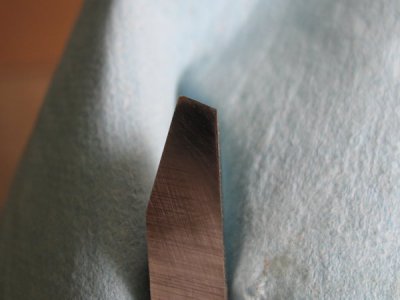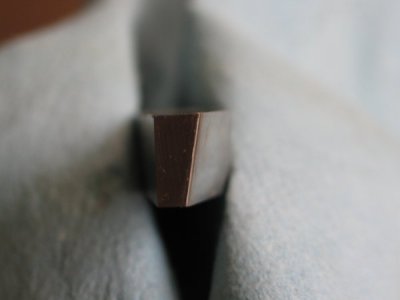- Joined
- Dec 20, 2012
- Messages
- 9,422
Topsy, I would like to make a few suggestions for when you grind a tool or have one made.
Brass tends to grab, as you've noticed. To get past that, a zero rake tool works best. Your current tool is a positive rake tool (the tip is higher than the back of the tool) and that will grab unless your lathe is very rigid, which a Unimat is not. Likewise, a negative rake tool creates very high cutting forces and requires a rigid lathe to cut well; again, your Unimat is not that rigid and will tend to chatter with a negative rake tool. Sooo, a zero rake tool is what you need for brass. This is just a tool with the shape you need and relief angles on the sides; the top of the tool is left flat and un-ground. As long as the tip of the tool is on center height, it will not grab.
Relief angles for brass need to be fairly large, on the order of 12 - 15 degrees. This creates a narrower included angle at the cutting edge that reduces cutting forces (good for a small lathe) and greatly improves the finish the tool creates.
Brass likes nose radii on the larger side, about 1/32" works well. This improves your finishes and makes up for the lack of back rake.
Hone your tools for brass and keep them sharp. With the right tool, brass cuts like butter.
Hope this helps.
Brass tends to grab, as you've noticed. To get past that, a zero rake tool works best. Your current tool is a positive rake tool (the tip is higher than the back of the tool) and that will grab unless your lathe is very rigid, which a Unimat is not. Likewise, a negative rake tool creates very high cutting forces and requires a rigid lathe to cut well; again, your Unimat is not that rigid and will tend to chatter with a negative rake tool. Sooo, a zero rake tool is what you need for brass. This is just a tool with the shape you need and relief angles on the sides; the top of the tool is left flat and un-ground. As long as the tip of the tool is on center height, it will not grab.
Relief angles for brass need to be fairly large, on the order of 12 - 15 degrees. This creates a narrower included angle at the cutting edge that reduces cutting forces (good for a small lathe) and greatly improves the finish the tool creates.
Brass likes nose radii on the larger side, about 1/32" works well. This improves your finishes and makes up for the lack of back rake.
Hone your tools for brass and keep them sharp. With the right tool, brass cuts like butter.
Hope this helps.





